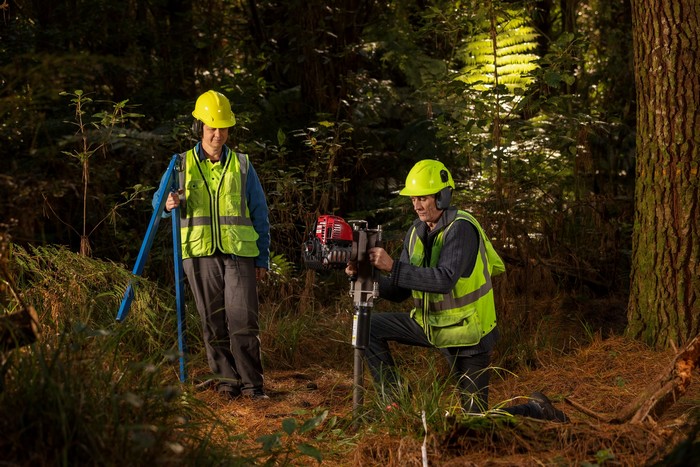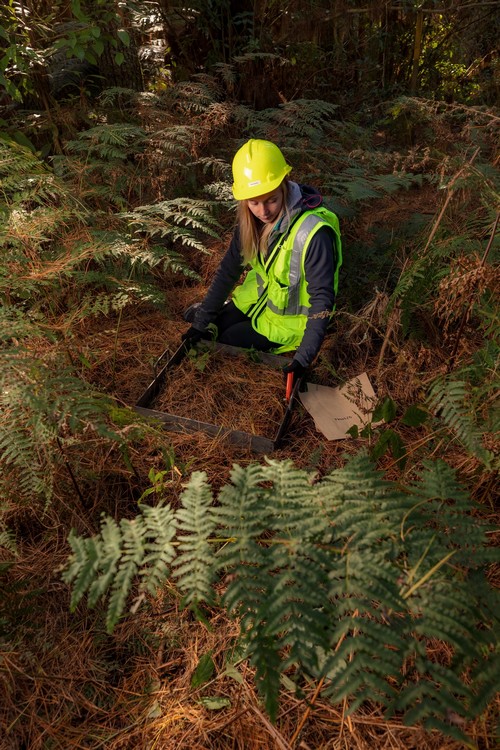Sustaining forest productivity

A 30-year experimental monitoring of forest ecosystem nutrient levels and forest productivity over a complete rotation has been completed by Scion researchers. The results show that soil nutrient levels and forest productivity can be maintained with site-specific management – specifically through the retention of forest harvest residues and the forest floor at low-fertility sites.
Around 15 percent of New Zealand’s planted radiata pine forests are now in their third or fourth rotation. A consistent supply of nutrients is essential to ensure the long-term productivity, health and sustainability of these forests. This is not a new issue, with concern being raised more than 40 years ago.
Effects of removing harvesting residues
Harvesting a forest includes removing the main stem but can also include removal of harvest residues (slash) and even the forest floor, a scenario which is becoming increasingly more plausible as biomass for bioenergy and biofuels are emerging as ways to diminish our reliance on fossil fuels. Understanding the consequences of these practices from one rotation to the next is necessary to ensure our forests stay productive into the future.
New Zealand is part of a global network of “Long Term Site Productivity” trials investigating the sustainability of intensive forest management harvesting practices and the pressures placed on soil resources. The first whole-of-rotation results have now been reported for forests around New Zealand.
Six experiments were planted between 1986 and 1994 throughout New Zealand. Harvesting treatments included removing the stem only, removing all forest residues (or the whole tree) and removing the whole tree and the forest floor. Soil samples were taken at all the sites before harvest and mid rotation. However, forests at Burnham and Kinleith were cleared at mid rotation for dairy conversion and the Golden Downs site was abandoned due to severe wind damage. Forests at Woodhill, Tarawera and Berwick all reached harvest age and soil samples were taken once again.
Most of the nutrients at the sites were held in the soil, but the amount varied considerably from site to site. For example, the sandy soil at Woodhill contained 1,000 N kg/ha while the fertile soils at Berwick contained 12,000 N kg/ha down to 1 m soil depth. At sites like Woodhill, low soil nitrogen levels meant a much greater percentage of the total nitrogen was present in the forest floor litter and therefore the effect of disrupting forest floor was likely to be greater.
As expected, more carbon and nutrients were removed when the forest floor was disturbed, which can happen during harvesting and preparation for planting.
However, by the end of the rotation, the forest floor had recovered. The one exception was forest floor removal at the Woodhill site where the soil is sandy and low in nutrients. There, removing the forest floor had a long-term impact on soil carbon and nitrogen. However, the removal of large amounts of nutrients in harvest residues and forest floor had no effect on wood quality. These results suggest the soils and forest floor were generally able to supply adequate amounts of nutrients and, with time, the nutrient stocks were replenished.
Effect of adding fertiliser
Fertiliser application was also part of the trial, with the intention of removing any nutrient limitations caused by the harvesting treatments. Consequently, very large amounts of nitrogen were applied over many years. This contrasts with the typical practice of applying no fertiliser, or up to 200 N kg/ha if trees are considered short on nitrogen.
Adding fertiliser increased early rotation productivity, mitigating the effect of removing the whole tree and whole tree plus forest floor. Fertiliser was especially effective at sites like Woodhill and Tarawera where carbon and nitrogen stocks were initially low. Although the added nitrogen could be used to counteract the negative effects of forest floor removal, further research is required to ascertain the amount required to offset forest floor removal.
Predicting nutrient levels
The nutrient balance model, NuBalM, was developed as a part of this work. NuBalM can predict nutrient levels over multiple rotations and is being used to support precision nutrient management and improve productivity and underpin sustainable forest management. The model also has wider application. For example, it can also be used to predict nitrogen that could then be leached under new land use scenarios, and this approach supports a pathway to engage with the OverseerFM land use model (the principle agricultural modelling system).

Applying what we have learnt
The results from this work are already being used by the forestry industry to develop and implement site-specific nutrient management plans. Understanding the potential effects of forestry residue removal on some sensitive sites allows for site specific harvesting (and preparation) plans that ensure residues are retained and evenly spread.
NuBalM is also being used to predict the cumulative effects of repeated harvest removals and to calculate how precision nutrition could be used to maintain or increase productivity. Some companies have also begun soil sampling and installing fertiliser trials.
NuBalM can be used to identify sites with greater fertility and that have the capacity to cope with intense harvest residue removal and sites where harvest residues should be retained. Knowing where forestry residues are available for use is vital for planning new forests and new processing plants in New Zealand to utilise forestry biomass in the move towards a carbon-neutral bioeconomy.
Microbial communities
These trials also provided the framework that supported several novel explorations of the soil microbial community present in New Zealand planted forests, and how their activity might influence tree health and productivity. Site treatments of removing the forest floor, and adding fertilisers at sites low in nutrients, were seen to reduce microbe diversity. These findings have contributed to expanding the scope of research exploring the potential to use the microbiome – microbes intimately connected with trees – to increase the resilience of planted forests to disease, drought and other stresses.
Sustainable future forests
New Zealand is the first country to complete and report on a full rotation of the Long Term Site Productivity harvest removal experiments, largely due to the rate at which radiata pine grows in this country. The work supports the pathway to a more sustainable forest industry as the global demand for wood and fibre places greater pressure on forest soils.
The ground-breaking work has added to our understanding of how forest ecosystem nutrient pools change over a rotation and over many rotations. The forest floor has been confirmed as an important store and source of nutrients, particularly on low nutrient sites, where retaining the forest floor is essential to maintain longterm nutrient supply. The monitoring strategies developed and deployed (NuBalM) give the industry new capability to predict critical soil fertility thresholds before they are reached and also to develop site specific management practices to preserve soil fertility and maintain forest productivity.
This work also demonstrates the sustainability of planted forestry in New Zealand, which is essential for public acceptance of commercial forestry, and to meet the requirements of external bodies such as the Forest Stewardship Council.
Funders include the Forest Growers Levy Trust, the New Zealand Forest Owners Association and the New Zealand Farm Forestry Association with historical input from the New Zealand Forest Service and numerous forest companies at the time of establishing and early management of the experiments.
